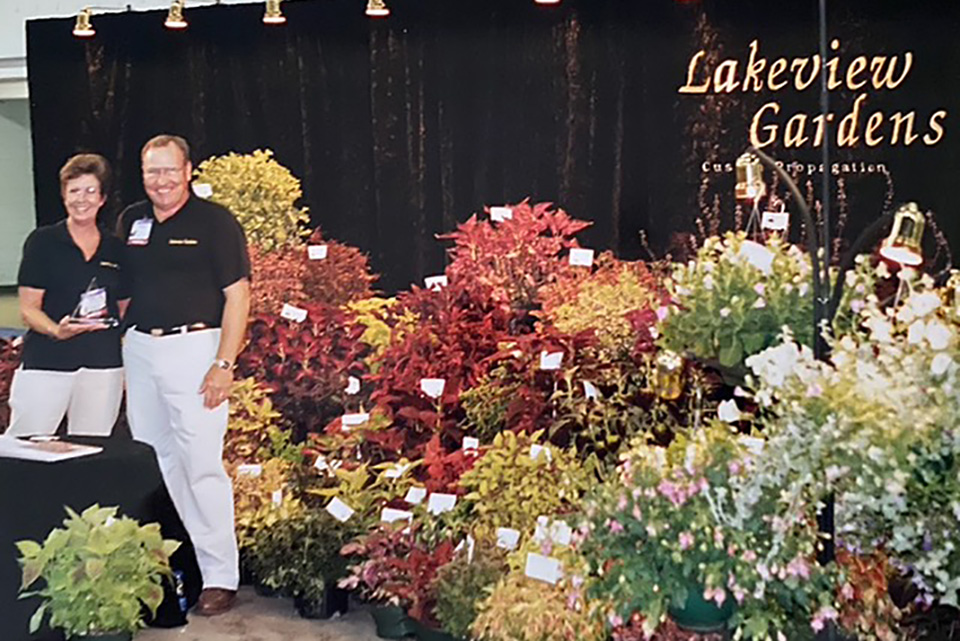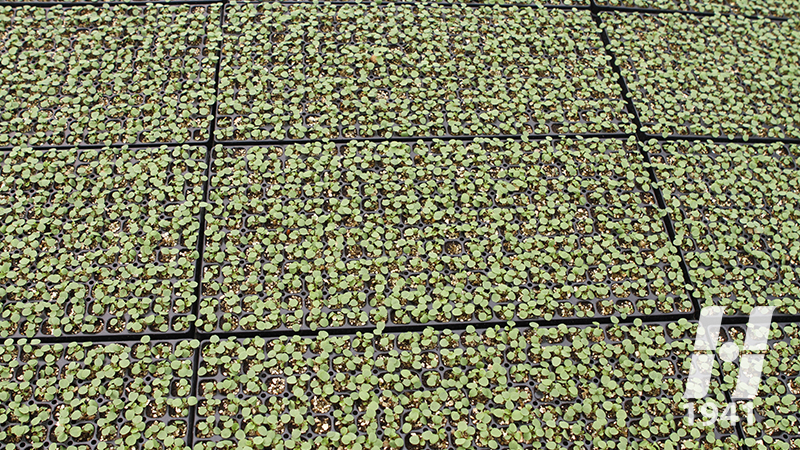Allan Armitage on Coleus: A Look Back, and a Look Forward

Wanda and Ralph Repp Jr. had an early rooting station for Flower Fields and their own coleus breeding. Photo: Allan Armitage
When I see the new plants displayed at California Spring Trials (CAST) and Cultivate, many of the same names appear. These include calibrachoa, petunias, impatiens, mixed containers, and perhaps an echinacea or dahlia. Yet, as a horticulturist who has seen plants ebb and flow in popularity, I try to remember where we were in order to appreciate where we are. So many plants, so much history!
I have been wanting to chat about one of my favorites, coleus, for some time now. As it turns out, I recently happened upon two very special cultivars within an hour of each other at CAST. One was a beautiful recent introduction from PanAmerican Seed called ‘Premium Sun Coral Candy’; the other was a coleus called ‘Alabama Sunset’, both recommended for the sun. As I viewed these plants, I realized I was looking at the history of sun coleus right in front of me. Every plant we sell today had its beginnings years ago. In our need for new, we sometimes forget about what got us here. Allow me to go back in time.
As a young student, I recall the professor telling us that only three annuals were reliably used for shady situations. These were begonia, impatiens, and coleus, known as the Holy Trinity for shade. I recall the seed flats of Sabers and Wizards, two very popular coleus series in the 1970s and 80s.
Circa 1983, I trialed ‘Alabama Sunset’. I put some in shade (of course) and others in the burning Georgia sun. I was stunned — it flourished in full sun and in fact did better than in the shade. As I researched it, I found that its correct name was ‘Bellingrath Pink’, as it originated from Bellingrath Gardens in Mobile, AL. I wrote about it, and soon people were discovering its full sun capability. That was the sun coleus that started it all.
After hearing about my excitement for coleus for the sun, my colleague Butch Ferree returned from a trip to Louisiana laden with cuttings of “sun coleus for Armitage.” Over the next few years, we trialed about 18 potential candidates in the full Georgia summer sun. We introduced seven of them.
In the late 1980s, they were introduced as the Sun Coleus Series, the first series of coleus recommended for full sun conditions. They went under names like ‘Rustic Orange’, ‘Gay’s Delight’, and ‘Olympic Torch’ to name but three. Even today, I continue to see both ‘Rustic Orange’ and ‘Gay’s Delight’, occasionally even with the correct name on the label. This was before the tsunami of patenting, so most were renamed or simply disappeared.
The very next year, I met George Griffith from Hatchett Creek Farms in Gainesville, FL. He was upset with me because he was about to introduce his new series of sun coleus, and I beat him to it. We had a wonderful collegial relationship and his series, named the Solar Series, was exceptional. Introduced in the late 1980s, they became the standard for sun coleus.
But then, oh my, the genie was out of the bottle, and from the 1990s into the early and mid 2000s, the beat went on. Glasshouse Works in Ohio started selling some of the newer sun coleus, then Flower Fields in California, then everyone jumped on the bandwagon. Another one of my exceptionally talented colleagues, Ralph Repp Jr. and his wife, Wanda, had an early rooting station for Flower Fields and his own breeding. By 2003, Lakeview Gardens in Waynesville, NC, had well over 100 cultivars in their catalog. The University of Florida’s coleus breeding program started around the same time and by the late 2000s, companies like Proven Winners and Ball Horticultural were offering their breeding. Today, every major company offering annuals has its own lines of coleus, and every one of them is recommended for sunny conditions. They have become rock stars on their own and best companions for petunias, calibrachoas, and scaevola in mixed containers.
From the meager beginnings of ‘Bellingrath Pink’, ‘Rustic Orange’, and ‘Solar Flare’, the popcorn kept popping, until we can say that there are well over 1,000 cultivars of sun coleus today.
The new coleus these days are more spectacular than ever. Let’s grow them, sell them, and let’s savor where we are; however let’s also appreciate the plants that got us here.









